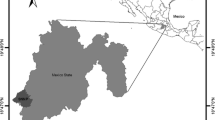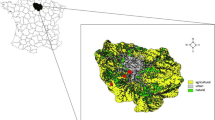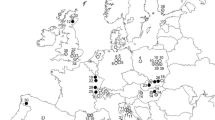Abstract
Dietary investigations of sympatric felids are means for understanding how closely related species deal with food resources in a potentially competitive scenario. The diets of the oncilla Leopardus tigrinus, the jaguarundi Puma yagouaroundi and the ocelot Leopardus pardalis were studied through the analysis of scats in Araucaria Pine Forest with Natural Grasslands of southern Brazil. Small mammals comprised the bulk of the diets of the three felids, followed by birds and reptiles. The smallest food-niche overlap index was 0.84, indicating that these felids shared an important portion of their food resources. Inter-species differences were detected in the consumption of the most frequent rodent prey; L. tigrinus was the only species that consumed all the most frequent rodent prey differently from the rate expected from their abundances. Although these findings suggest competitive interactions, with the oncilla being the most subordinate species, further experimental investigations are necessary to elucidate more precisely how these syntopic felids coexist. The effects of sample size and its influences on the evaluation of the diets of the felids, especially of the ocelot, are discussed. We compare our data to a previous study in the same area, to account for the possible influences of biased sampling and uneven distribution of food resources on the diet of the ocelot. The opportunistic feeding behavior and the abundance of their primary prey (cricetid rodents) seem to allow these small cats to be resilient despite severe anthropogenic disturbance in the study area. We further suggest guidelines for future studies in the study region, in order to understand the dynamics of mammalian carnivores demography.
Similar content being viewed by others
References
Abreu, K.C., Moro-Rios, R.F., Silva-Pereira, J.E., Miranda, J.D.M., Jablonski, E.F., Passos, F.C., 2008. Feeding habits of ocelot (Leopardus pardalis) in Southern Brazil. Mamm. Biol. 73, 407–411.
Aranda, M., Sanchez-Cordero, V., 1996. Prey spectra of jaguar (Panthera onca) and puma (Puma concolor) in tropical forests of Mexico. Stud. Neotrop. Fauna Environ. 31, 65–67.
Azevedo, F.C.C., 2008. Food habits and livestock depredation of sympatric jaguars and pumas in the Iguaçu National Park, South Brazil. Biotropica 40, 494–500.
Bianchi, R.C., Mendes, S.L., 2007. Ocelot (Leopardus pardalis) predation on primates in Caratinga Biological Station, southeast Brazil. Am. J. Primatol. 69, 1–6.
Bonvicino, C.R., Oliveira, J.A., D’Andrea, P.S., 2008. Guia dos roedores do Brasil, com chaves para gêneros baseadas em caracteres externos. OPAS/OMS, Rio de Janeiro.
Byers, C.R., Steinhorst, R.K., Krausman, P.R., 1984. Clarification of a technique for analysis of utilization-availability data. J. Wildl. Manage. 48, 1050–1053.
Caro, T.M., Stoner, C.J., 2003. The potential for interspecific competition among African carnivores. Biol. Conserv. 110, 67–75.
Carvalho, J.C., Gomes, P., 2004. Feeding resource partitioning among four sympatric carnivores in the Peneda-Gerês National Park (Portugal). J. Zool. 263, 275–283.
Chinchilla, F.A., 1997. La dieta del jaguar (Panthera onca), el puma (Felis concolor) yel manigordo (Felis pardalis) (Carnivora: Felidae) en el Parque Nacional Corcovado, Costa Rica. Rev. Biol. Trop. 45, 1223–1229.
Davies, T.J., Meiri, S., Barraclough, T.G., Gittleman, J.L., 2007. Species co-existence and character divergence across carnivores. Ecol. Lett. 10, 146–152.
Di Bitetti, M.S., De Angelo, C.D., Di Blanco, Y.E., Paviolo, A., 2010. Niche partitioning and species coexistence in a Neotropical felid assemblage. Acta Oecol. 36, 403–412.
Durant, S., 1998. Competition refuges and coexistence: an example from Serengeti carnivores. J. Anim. Ecol. 67, 370–386.
Emmons, L.H., 1987. Comparative feeding ecology of felids in a neotropical rainforest. Behav. Ecol. Sociobiol. 20, 271–283.
Facure, K.G., Giaretta, A.A., 1996. Food habits of carnivores in a coastal Atlantic Forest of southeastern Brazil. Mammalia 60, 499–502.
Futuyma, D.J., Moreno, G., 1988. The evolution of ecological specialization. Annu. Rev. Ecol. Syst. 19, 207–233.
Greene, H.W., Jaksic, F.M., 1983. Food-niche relationships among sympatric predators: effects of level of prey identification. Oikos 40, 151–154.
Griffiths, D., 1975. Prey availability and the food of predators. Ecology 56, 1209–1214.
Hayward, M.W., Henschel, P., O’Brien, J., Hofmeyer, M., Balme, G., Kerley, G.I.H., 2006a. Prey preferences of the leopard (Panthera pardus). J. Zool. 270, 298–313.
Hayward, M.W., Hofmeyer, M., O’Brein, J., Kerley, G.I.H., 2006b. Prey preferences of the cheetah Acinonyx jubatus; morphological limitations or the need to capture rapidly consumable prey before kleptoparasites arrive? J. Zool. 270, 615–627.
Hayward, M.W., Kerley, G.I.H., 2005. Prey preferences of the lion (Panthera leo). J. Zool. 267, 309–322.
Hayward, M.W., Kerley, G.I.H., 2008. Prey preferences and dietary overlap amongst Africa’s large predators. S. Afr. J. Wildl. Res. 38, 93–108.
Hayward, M.W., Slotow, R., 2009. Temporal partitioning of activity in large African carnivores: tests of multiple hypotheses. S. Afr. J. Wildl. Res. 39, 109–125.
Jaksic, F.M., 1989. Opportunism vs selectivity among carnivorous predators that eat mammalian prey: a statistical test of hypotheses. Oikos 56, 427–430.
Kiltie, R.A., 1984. Size rations among sympatric Neotropical cats. Oecologia 61, 411–416.
Konecny, M.J., 1989. Movement patterns and food habits of four sympatric carnivore species in Belize, Central America. Adv. Neotrop. Mammal., 243–264.
Krebs, C.J., 1999. Ecological Methodology. Addison Wesley Education Publishers, New York.
Linnell, J.D.C., Strand, O., 2000. Interference interactions, co-existence and conservation of mammalian carnivores. Divers. Distrib. 6, 169–176.
Ludlow, M.E., Sunquist, M.E., 1989. Ecology and behaviour of ocelots in Venezuela. Nat. Geogr. Res. 3, 447–461.
Maack, R., 1981. Geografia Física do Estado do Paraná. Secretaria da Cultura e do Esporte do Governo do Estado do Paraná, Curitiba.
Manzani, P.R., Monteiro-Filho, E.L.A., 1989. Notes on the food habits of the jaguarundi. Felis yagouaroundi (Mammalia: Carnivora). Mammalia 53, 659–660.
Moreno, R.S., Kays, R.W., Samudio Jr., R., 2006. Competitive release in diets of ocelot (Leopardus pardalis) and puma (Puma concolor) after jaguar (Panthera onca) decline. J. Mammal. 87, 808–816.
Novack, A.J., Main, M.B., Sunquist, M.E., Labisky, R.F., 2005. Foraging ecology of jaguar (Panthera onca) and puma (Puma concolor) in hunted and non-hunted sites within the Maya Biosphere Reserve, Guatemala. J. Zool. 267, 167–178.
Pianka, E.R., 1994. Evolutionary Ecology. HarperCollins College Publishers, New York.
Pierce, B.M., Bleich, V.C., Bowyer, T., 2000. Selection of mule deer by mountain lions and coyotes: effects of hunting style, body size, and reproductive status. J. Mammal. 81, 462–472.
Quadros, J., Monteiro-Filho, E.L.A., 2006. Coleta e preparação de pêlos de mamíferos para identificação em microscopia óptica. Rev. Bras. Zool. 23, 274–278.
Ray, J.C., Sunquist, M.E., 2001. Trophic relations in a community of African rainforest carnivores. Oecologia 127, 395–408.
Reis, N.R., Peracchi, A.L., Pedro, W.A., Lima, I.P., 2006. Mamíferos do Brasil. Universidade Estadual de Londrina.
Rosenzweig, M.L., 1966. Community structure in sympatric Carnivora. J. Mammal. 47, 602–612.
Scognamillo, D., Maxit, I., Sunquist, M.E., Polisar, J., 2003. Coexistence of jaguar (Panthera onca) and puma (Puma concolor) in a mosaic landscape in the Venezuelan llanos. J. Zool. 259, 269–279.
SEMA, 2004. Plano de Manejo da Área de Proteção Ambiental da Escarpa Devoniana. SEMA and IAP, Curitiba.
Solari, S., Rodrigues, J.J., 1997. Assessment and monitoring mammals: small and nonvolant mammals. In: Dallmeier, F., Alonso, A. (Eds.), Biodiversity Assessment and Long-term Monitoring, Lower Urubamba Region. Smithsonian Institution Monitoring Assessment of Biodiversity Program, Washington, DC, pp. 281–290.
Sunquist, M.E., Sunquist, F., 2002. Wild Cats of the World. University of Chicago, Press, Ltd., London.
Umetsu, F., Naxara, L., Pardini, R., 2006. Evaluating the efficiency of pitfall traps for sampling small mammals in the neotropics. J. Mammal. 87, 757–765.
Villa-Meza, A., Meyer, E.M., Lopes-Gonzáles, C.A., 2002. Ocelot (Leopardus pardalis) food habits in a tropical deciduous forest of Jalisco, Mexico. Am. Midl. Nat. 148, 146–154.
Wang, E., 2002. Diets of ocelots (Leopardus pardalis), margays (L. wiedii), and oncillas (L. tigrinus) in the Atlantic Rainforest in Southeast Brazil. Stud. Neotrop. Fauna Environ. 37, 207–212.
Author information
Authors and Affiliations
Corresponding author
Rights and permissions
About this article
Cite this article
Silva-Pereira, J.E., Moro-Rios, R.F., Bilski, D.R. et al. Diets of three sympatric Neotropical small cats: Food niche overlap and interspecies differences in prey consumption. Mamm Biol 76, 308–312 (2011). https://doi.org/10.1016/j.mambio.2010.09.001
Received:
Accepted:
Published:
Issue Date:
DOI: https://doi.org/10.1016/j.mambio.2010.09.001




